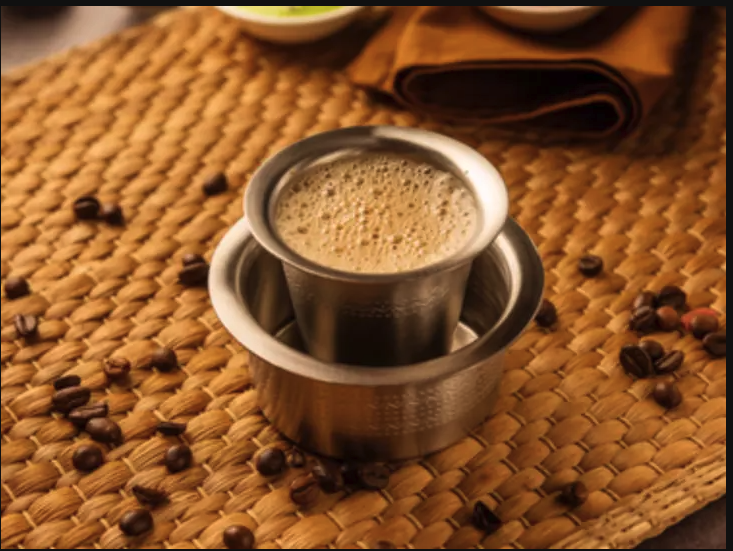South Indian Filter Coffee: The Ultimate Guide to Perfecting Filter Coffee

The rich, frothy bubbles crowning a cup of freshly brewed coffee, with wisps of steam rising from silver or brass tumblers, creates a delightful image that captivates coffee lovers everywhere. This ritual is an integral part of daily life in South India, where filter coffee—or kaapi—holds a special place in hearts and homes. Enjoyed with a side of a local newspaper, this tradition brings together the comfort of home and the skillful art of coffee-making.
For coffee enthusiasts, especially in South India, freshly brewed filter coffee is irreplaceable. This guide takes you through every step and ingredient that goes into making an unforgettable cup of South Indian filter coffee, from the selection of coffee beans to the ideal decoction-to-milk ratio.
The Origins: A Journey from Arabia to South India
South Indian coffee lovers owe their brew’s existence to Baba Budan, a Muslim saint from Karnataka who, in the 17th century, smuggled coffee beans from Arabia. The Middle East had a monopoly over coffee at the time, prohibiting the export of raw beans. Legend has it that Baba Budan hid seven coffee beans in his beard, bringing them to the Chandragiri Hills of Chikmagalur, Karnataka, where they eventually flourished. By the 19th century, coffee culture had taken root in South India, as the British expanded its reach. In northern India, coffee culture would gain traction only later in the 20th century, with the establishment of the Indian Coffee House.
Freshly Ground vs. Instant Coffee
In today’s busy world, instant coffee has become a popular alternative due to its convenience. However, true South Indian filter coffee relies on ground coffee, especially high-quality Arabica beans, which provide a depth of flavor and aroma that instant coffee lacks. Instant coffee, mostly made from Robusta beans and processed through spray-drying, sacrifices much of coffee's natural richness. In contrast, South Indian filter coffee is crafted with precision, from selecting beans to blending ingredients.

Essential Ingredients for Authentic Filter Coffee
To achieve the unique taste of South Indian filter coffee, three key ingredients are typically blended: Plantation-A coffee, Peaberry, and Chicory.
- Plantation-A Coffee
Often considered the highest grade in India, Plantation-A refers to high-quality Arabica beans with minimal imperfections. This coffee offers a bold, smooth profile that forms the base of South Indian filter coffee. - Peaberry Coffee
Peaberries are small, round beans known for their complex flavors and bright acidity, adding a hint of sweetness to the brew. Though rare and thus more expensive, Peaberry is cherished by those who enjoy a balanced sweetness in their coffee. - Chicory
Chicory, a coffee-like root that adds sweetness and body to the coffee, is often blended at a ratio of 10-20%. It balances the strong flavor of coffee while adding an authentic touch to South Indian brews. Chicory is ideal for enhancing flavor, especially when the goal is to produce a smooth, creamy coffee rather than a highly caffeinated drink.

Roasting and Grinding: Perfecting Flavor and Texture
The roasting and grinding processes are key to the flavor and aroma of South Indian filter coffee. The beans go through endothermic and exothermic reactions during roasting, darkening as they develop the signature aroma. A medium roast works best for filter coffee, bringing out a balanced flavor profile.
When it comes to grinding, the medium-fine grind is optimal for filter coffee, striking a balance between a coarse and extra-fine texture. This ensures the decoction is neither too weak nor overpowering, resulting in a smooth, well-rounded taste.
Blending Ratios: Crafting the Ideal Cup
For an authentic South Indian experience, Plantation-A coffee is often blended with chicory, with popular ratios being 80% coffee to 20% chicory or 90% coffee to 10% chicory. For a milder flavor with lower caffeine, some prefer increasing chicory content up to 40-50%, though this compromises some coffee intensity. Including Peaberry, with ratios such as 45% Peaberry, 45% Plantation-A, and 10% chicory, enhances the cup’s brightness and body, though it is optional.
Brewing Filter Coffee: Step-by-Step Guide
Step 1: Boil water until its temperature reaches 100 degrees for the perfect brew.
Step 2: Add 3-4 tablespoons of filter coffee powder to the cylindrical structure with perforations and mount it on top of the cylindrical collector. Once it sits, press the powder with the pressing disc. Allow the disc to sit on the powder and pour the boiled water onto the filter. Pour water to the brim and close the lid. Let it brew for 15-20 minutes.
In the absence of a filter coffee press/filter, a netted sieve can be used with a lining of muslin cloth on top. Place a bowl underneath the sieve to collect the decoction.
Step 3: Remove the cylindrical collector which will have the decoction. Add decoction to hot milk (any milk of your choice) in a 1:4 ratio. Add sugar to taste.
Step 4: Mix it well and top it off with a teaspoon of decoction.
Serving Style: The Traditional Tumbler and Dabarah
To fully appreciate South Indian filter coffee, it’s traditionally served in a tumbler and dabarah. The coffee is poured back and forth between the two, cooling it slightly and creating an irresistible froth. This ritual is more than a serving style; it’s a celebration of coffee culture, embodying the sentiment that “Coffee is a drink; filter coffee is an emotion.”

Conclusion
Crafting a cup of South Indian filter coffee involves thoughtful ingredient selection, expert roasting, and mindful brewing techniques. With each sip, this aromatic, flavorful beverage pays homage to a centuries-old tradition rooted in quality and dedication to taste. Whether served at home or in a bustling café, South Indian filter coffee remains an experience that coffee lovers around the world cherish.
